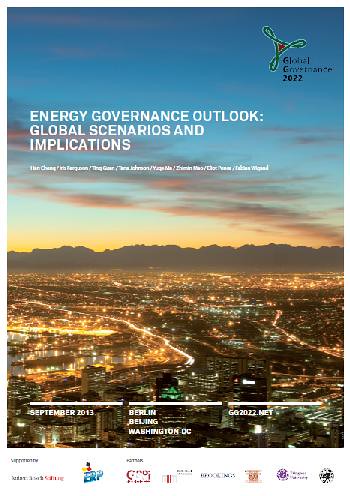GG2022 – Energy Governance Outlook: Global Scenarios and Implications
This report summarizes the work of the GG2022 working group on global energy governance. To explore possible futures in global energy governance, the working group used a scenario planning methodology with techniques developed extensively in the field of future studies. The diverse nationalities, backgrounds, and expertise of working group members contributed crucial assets for devising national strategies and solutions. For more information on the GG2022 please see here.
Executive Summary
Major technological, economic and political shifts are remaking the global energy market. Emerging economies have become top energy consumers. Technological breakthroughs have fueled the rise of new energy producers. And energy regimes such as the Organization of the Petroleum Exporting Countries (OPEC) are under increasing pressure to reform. Uncertainty remains. Turmoil in the Middle East remains a trigger for concerns over supply. Fallout from the financial crisis remains a core concern for both developed and developing countries. Carbon emissions are increasing faster than expected. Further, while clean technologies have become more affordable, structural limitations, including the continuation of financial subsidies and poor systems integration, undermine their take-up.
In the face of these challenges, the current state of global energy governance is in remission. International dialogue on energy is limited. International climate policy has lost momentum. Energy markets on the whole remain as volatile and unpredictable as ever.
Structured scenario planning has become commonplace among private and public sector organizations alike. The methodology and development of scenarios is designed to facilitate strategic long-term planning in the face of this uncertain future.
The GG2022 energy group has used scenario planning methodology to create two distinct scenarios for the energy world in 2022. In both scenarios, we identify unconventional fossil fuels as a primary factor that will significantly impact global energy markets and change not only the size, structure and membership of existing energy institutions, but also their relevance and influence. Though major uncertainties concerning the size of the reserves of unconventional resources and the environmental impact of the methods used to extract them still exist today, the political and economic momentum that their extraction has generated fundamentally reshapes global energy markets. As a result, their exploration, extraction and production emerge as fundamental issues in global energy governance.
Will existing power structures ignore, integrate, or defend against unconventional resources? Will the new unconventional sources be made available to the global market or will their supply remain limited to producing countries? What will be the effect on countries without domestic supplies? What room does global energy governance have to shape these new rules of the game on energy trade and what will be the implications on the climate change framework? How should the energy governance institutions adapt to this changing environment?
We investigate these questions in two scenarios for the year 2022, one with a fragmented world, another with an integrated world. Both scenarios share important key assumptions – the emergence of new energy consumer- and supplier-countries and the availability of unconventional fossil fuel sources.
SCENARIO 1: Within the “Fragmented World” scenario, countries focus on controlling energy assets rather than trading energy on a global market. Regional trading blocs emerge based on longer-term supply agreements. Resource conflicts surface over disputed resource-rich territories. While global climate change negotiations are moribund, some of the regional energy partnerships lead to substantial investments in clean technology.
SCENARIO 2: By contrast, in the “International Market Integration” scenario, countries demonstrate growing confidence in the global energy market. New producer countries generate a “supply cushion” that reverses long-held assumptions about strategies for securing energy supplies, gradually enticing entrants into the global energy market. In turn, new consuming countries also source from the global market. Regional investment treaties provide standardization of norms through which international investment and trading rules are improved. Closer cooperation in energy trade spills over to other energy governance areas and creates a platform for climate leadership and regional climate agreements.
By examining these contrasting visions for the next 10 years, the GG2022 energy group was able to identify lead strategies – that is, policy options that are suitable for both of these different scenarios. Each lead strategy addresses one or more of the following four goals: (1) energy affordability, (2) energy availability, (3) energy accessibility, (4) energy sustainability. The resulting policy options are:
Scale up energy transport. This includes liquefied natural gas (LNG) import/export terminals, pipelines, and electricity grids. This option also involves a clear regulatory framework, concessional finance, and long-term off-take contracts in order to improve investor security for the needed infrastructure investments. Procedures for determining infrastructure investments will need to be streamlined in order to get the necessary infrastructure in place, but those procedures must also allot time to engage affected communities and other stakeholders.
Bolster energy-related legal and trade instruments. This includes standardized investment treaties that provide fair and equitable treatment, protection from expropriation, and mechanisms for dispute resolution. These investment treaties should have application at multiple legislative levels and work to normalize best practices and market frameworks for energy trade.
Implement energy knowledge-sharing and capacity-building mechanisms for emerging economies and developing countries. This includes agreements and institutions to collect data and disseminate best practices on energy technologies and environmental protection. Such mechanisms must involve multiple stakeholders in information exchange in order to encourage countries to meet their growing energy needs in a secure and sustainable way.
Accelerate clean-technology development and penetration through bilateral and regional institutions. While non-state actors are increasingly forming alliances to reduce carbon emissions, states must work to keep climate change on the policy agenda. In emerging bilateral and regional energy treaties, regional climate agreements could be inserted as well. This will continue the effort to mitigate climate change, even if a global climate policy agreement cannot be reached.
More closely incorporate emerging economies in existing international energy institutions. It is likely that, absent major changes, global governance of energy will continue to be relatively weak and decentralized. Nevertheless, modest changes are feasible in the near future in order to facilitate dialogue on energy technology and trade. The International Energy Agency (IEA) could extend formal membership to countries such as China and India, while the G20 could provide greater leadership and coordination among and between developed and emerging economies.
To read the full report please click the below image:
For academic and practitioner responses to this report please see here.



